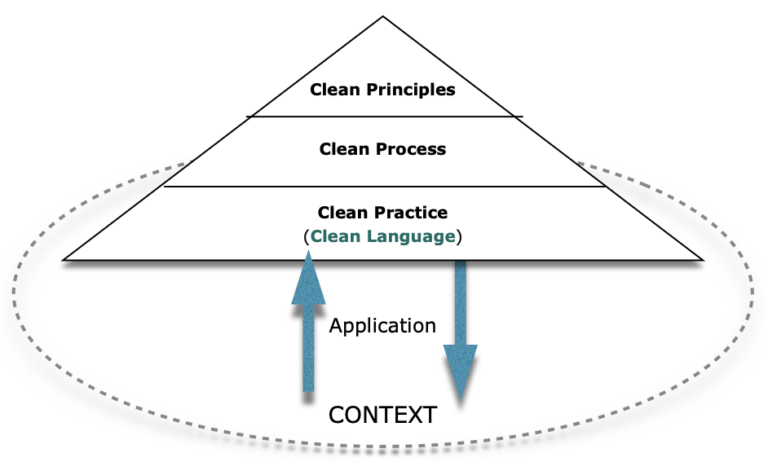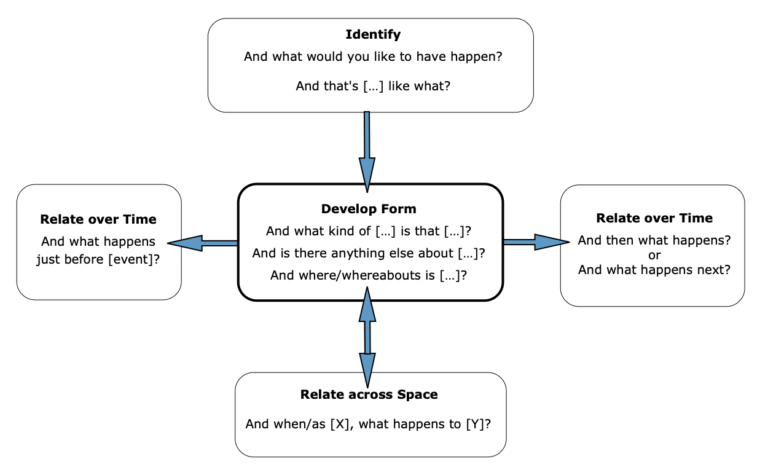Published in Rapport 81, Winter 2023
Ernest Rossi (Milton Erickson’s long-time collaborator)
What Clean Language is
Clean approaches encourage people to express themselves with maximum freedom – minimally constrained or contaminated by a facilitator’s concepts and assumptions about the way people or the world works.
Clean Language is what the facilitator does with their words, their voice and their body. You can capture Clean Language on video. It’s the behaviour required to facilitate a clean application. It is ‘content-free’ and ‘non-leading’ in that it does not presuppose a client’s subjective experience has any particular characteristics other than a few universal ways people use time and space to organise their experiences.
While it’s impossible to eliminate a facilitator’s assumptions entirely from the wording of a question, clean questions almost exclusively make use of what linguists call ‘semantic primes’. These are concepts that cannot be expressed in simpler terms and that appear in every language studied. Surprisingly, there are remarkably few of these concepts.1
Although Grove originally developed Clean Language to work with a client’s metaphoric or symbolic domain of experience, Clean Language is just as comfortable working with conceptual and sensory descriptions.
What Clean Language isn’t
In a previous article (Rapport, 80) we distinguished between the field of Clean, the practice of Clean Language, the many clean processes and the general principles that guide a clean facilitator (Figure 1).
Clean Language, by itself, is not a method. A method involves a process for accomplishing something. It’s a systematised application of principles and behaviours in a particular context for a purpose. While David Grove developed many clean processes, such as Clean Space and Emergent Knowledge, many more have been developed by other people, e.g. Symbolic Modelling, Clean Language Interviewing, Metaphors at Work, Systemic Modelling, Modelling Shared Reality, and The Five-Minute Coach, to name only a few.

Clean Questions

Function of a clean question
While modelling David Grove we had a major breakthrough. We realised the key function of his questions was not to elicit information, but rather to invite the client to attend to somewhere, somewhen or somewhat within their inner world. The effectiveness of the questions came from what the client did with their mind-body to process or make sense of the question.
Figure 2 is less about a categorisation of the questions and more like a compass. The arrows signify where each question invites the client to attend to within their internal world: to identify and elaborate (and stay with) an aspect of their experience; or move in a direction (back or forward in time); or across perceptual space.
The eight basic Clean Language questions embody five principles:
- Acknowledge experience just as it is described.
- Accurately preserve and utilise expressions of experience.
- Attend to aspects of experience congruent with those expressions.
- Only presuppose near-universal aspects of human experience.
- Have no intention to change a person or their experience.
Let’s be clear: Clean Language influences and directs attention. All language does this. However most language directs attention to aspects outside of what a person has expressed. Clean Language works within their frames of reference.
Unusual features
Clean Language questions have several unusual features. Firstly, they all start with ‘and’, emphasising that what is about to follow is contiguous with what has already been expressed.
Secondly, clean questions do not reference the facilitator. For example, we do not ask the client to “tell me about …” since we want to encourage their attention to stay with themselves.
Thirdly, paraphrasing is not part of Clean Language. Every paraphrase introduces something new into the conversation and therefore potentially reframes it. While reframing is valuable in some contexts, clean questions incorporate the client’s precise phraseology in order to preserve the idiosyncratic association with their richer more extensive network of experiences.
Fourthly, the facilitator does not mirror the client’s body posture and gestures. Instead we look at and gesture to the location of the symbols in their perceptual space from their perspective.
Written on a page clean questions can appear ‘mechanical’ and ‘lacking empathy’. But when said slowly with a tonality and rhythm of genuine curiosity for how a person constructs their personal reality, they are received by the client’s body as much as their mind.
Clean Language and change
Clean questions by themselves do not constitute a change process. Moreover, none of the questions include an intention to remove or reframe any aspect of a clients experience, including the ones the client perceives as problematic. Clean Language leaves the intention for change with the client. Changes happen frequently and mostly spontaneously as an organic by-product of the client’s self-enquiry and self-modelling process.
The following extract from the beginning of a Symbolic Modelling session with a Ukrainian psychologist illustrates Clean Language’s key features (F = Penny or James; C = Client; Clean Language questions are in bold):4
|
C |
I was going to return home. But then I get news that there was a chemical attack and I got back my feelings that everywhere in Ukraine is not safe. So I got a feeling that two parts of me are in conflict and then I have such a feeling that – kind of like the Earth is dropping from my feet, like down from my feet. |
|
F |
And when it feels like the earth is dropping from your feet, what would you like to have happen? |
|
C |
I would like this to stop; that the Earth would not drop down. |
|
F |
And you would like this to stop, that the Earth would not drop down. And when this stops, then what happens? |
|
C |
And then I stop. I stop to collect my things. And I’m stopping to collect my stuff and I stay at home. I’m not running away. |
|
F |
And you stop and collect your things and stay at home and not run away. And when you stay at home like that, what kind of stay at home is that? |
|
C |
I have two simultaneous pictures here and one of them is about the desired outcome where I live a normal full life. Another one is, it’s still unsafe to stay here and I have to collect my stuff and run away. |
|
F |
And when you have those two simultaneous pictures, what would you like to have happen when you have those two pictures? |
|
C |
That only one picture would be left, the one with the full life. |
|
F |
And you’d like only the one picture. The one with the full life. And what kind of picture is thatpicture? |
|
C |
Now I’ve got an idea that I should be real and not want that picture to disappear, but to get some way to unite both pictures |
We start by acknowledging the client’s experience, a metaphor for how she is reacting to an inner conflict resulting from the outer conflict of war. We do not ask what she wants instead of her problem, rather we enquire what would she like to have happen, given this is her experience.
In response the client expresses a desire to “stop” the problem, so we invite her to consider what happens when “the Earth does not drop down”. Within two questions the client has smoothly transitioned from describing her problem to defining how she would like it to be, “To collect my stuff and I stay at home”.
The client’s attention turns to “two simultaneous pictures”. We do not ‘side’ with either picture nor attempt to facilitate her to resolve the “two parts in conflict”. Rather we invite her to consider what she would like to have happen, when she has those two pictures. The client realises that she “should be real” and identifies a new desired outcome to “unite both pictures” – setting a direction for the rest of the session.
This short extract illustrates how our Problem-Remedy-Outcome (PRO) model works in practice.5
As the session progresses, the client accesses a resource metaphor, “a lullaby when you’re wrapped in a blanket and held in the hands of the mother”. Spontaneously the client becomes the mother and then the two parts that were in conflict can “peacefully coexist and help each other”. The result was that the client, “feels more steady, safe and confident. And though there is still a feeling of un-safety around, at the same time I feel that I’m able to manage with it, to cope with it.”
To conclude
Making use of Clean Language questions is a continuum. ranging from using one or two clean questions in almost any situation, to strictly adhering to the five principles listed above. Clean Language is the embodiment of a clean stance – the relationship a clean facilitator has with another person and their inner world. As David Grove said, “Clean Language is deeply agreeable to the client’s heart and soul”.
References
1 Goddard, C. & Wierzbicka, A. (2014). Words and Meanings: Lexical semantics across domains, languages and cultures.
2 Lawley, J. & Tompkins, P. (2000). Metaphors in Mind: Transformation through Symbolic Modelling, pp. 282-283.
3 Lawley, J (2023). Context makes Clean clean. cleanlanguage.com/context-makes-clean-clean
4 Full transcript available at cleanlanguage.com/coping-with-un-safety
5 Tompkins, P. & Lawley, J. (Feb 2006). Coaching for P.R.O.’s: The Problem, Remedy, Outcome model. Coach the Coach. cleanlanguage.com/coaching-for-pros
Part 1 of this three-part series is available at:
Modelling in the Symbolic Domain
Part 3 is available at:
Resources, embodied metaphor and Clean Language







